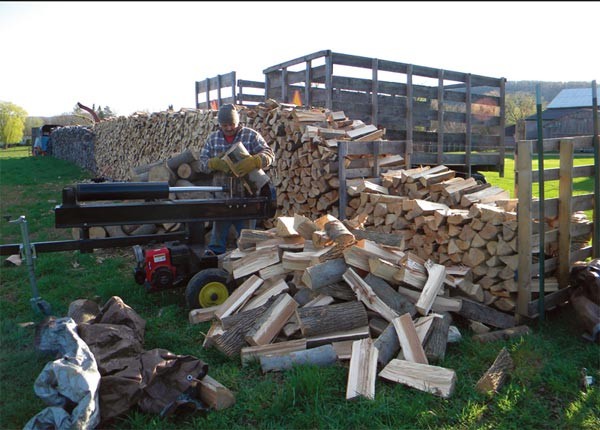
Did you know that a chunk of green firewood can be over 50 percent water? Of course you did. You’ve tried to burn that wood, and it was no more combustible than celery. So now you season your firewood before you burn it. But just how well are you seasoning that wood?
Burning green wood requires about 30 percent of the wood’s BTUs to be used to drive moisture out of the wood. Whether you buy your wood or cut and split it yourself, that loss of potential heat is an insult to either your wallet or your back. The cooler combustion you get from green wood creates cooler smoke, which tends to condense and adhere to your flue. The resulting hardened tar-like substance is creosote – a flammable combination of carbon and incompletely burned oils. Creosote plays a major role in chimney fires.
Cut and split firewood needs time, cover, and air circulation to season. Wood is considered seasoned when the “free water” (the liquid and vapor in cell cavities) migrates to the surface and the end of a log and evaporates. Time is pretty much a set variable; as a general rule, you’ll need six months to a year for the moisture content to drop to between 20 and 25 percent. Without proper coverage, though, your wood can reabsorb moisture.
For some years, I stacked my wood on a north-south axis and covered it with metal roofing. It was kept off the ground with wooden rails. While the air circulation it had was excellent, the cover wasn’t that good. Inevitably, rainwater would leak through seams and holes in the metal, and the exposed wood ends would get soaked by rain. In the end, the wood would be wet or covered with snow by the time I had to burn it for heat. And then there was that hissing and bubbling at the ends when I burned it. My wood was technically seasoned but was still wet, even though it had been split, stacked, and “covered” for nine months.
Think of wood as a sponge. On those breezy, warm, low-humidity days in June, it drys well and quickly. But then during those raw, rainy October and November days, the wet wood ends reabsorbed moisture. Good air circulation, bad coverage. It can also be difficult to season wood that is magnificently covered, as in a basement or under a heavy tarp, because there is little air circulation to carry away the moisture as is comes out of the wood. You can’t dry out a sponge in a Ziploc bag, right?
A word about bark. Bark is like a lid on a piece of wood if the wood is stacked bark up. It will keep some water from being absorbed into the wood if it is stacked in the elements. Likewise, it will help to prevent moisture from escaping from the wood. So stack bark up if your wood is exposed to weather, bark side down if it is completely covered.
Far and away the best solution is a woodshed that completely covers the wood from the elements but also allows the free flow of air on at least two sides. You get the benefit of great air circulation from warm breezes, which carry away the moisture driven out of the wood, but at the same time, the wood cannot reabsorb moisture because it is always covered and therefore dry. Be sure to get it up off the ground – wood can absorb moisture from below, even in a woodshed. And stack your wood in your shed bark-side down.
You may find that the cost of building a woodshed will pay for itself in just a few short years with the BTUs saved. Both your wallet or your back will thank you.

